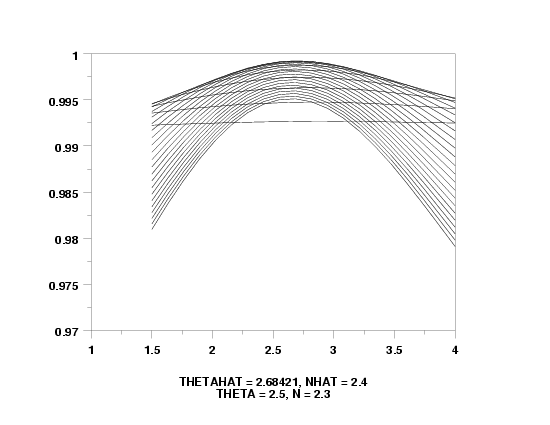

|
TSOPDFName:
 . .

with n denoting the shape parameter and
This distribution can be extended with lower and upper bound parameters. If a and b denote the lower and upper bounds, respectively, then the location and scale parameters are:
scale = b - a The general form of the distribution can then be found by using the relation

Kotz and Van Dorp note that the two-sided ogive distribution
is smooth at the reflection point (x =
<SUBSET/EXCEPT/FOR qualification> where <x> is a number, parameter, or variable containing values in the interval (a,b); <y> is a variable or a parameter (depending on what <x> is) where the computed two-sided ogive pdf value is stored; <n> is a number, parameter, or variable in the interval (≥ 0.5) that specifies the first shape parameter; <theta> is a number, parameter, or variable in the interval (a,b) that specifies the second shape parameter; <a> is a number, parameter, or variable that specifies the lower bound; <b> is a number, parameter, or variable that specifies the upper bound; and where the <SUBSET/EXCEPT/FOR qualification> is optional. If <a> and <b> are omitted, they default to 0 and 1, respectively.
LET Y = TSOPDF(X,1.5,2.2,0,5) PLOT TSOPDF(X,1.5,2.2,0,5) FOR X = 0 0.01 5
LET N = <value> LET A = <value> LET B = <value> LET Y = TWO-SIDED SLOPE RANDOM NUMBERS FOR I = 1 1 N TWO-SIDED SLOPE PROBABILITY PLOT Y TWO-SIDED SLOPE PROBABILITY PLOT Y2 X2 TWO-SIDED SLOPE PROBABILITY PLOT Y3 XLOW XHIGH TWO-SIDED SLOPE KOLMOGOROV SMIRNOV GOODNESS OF FIT Y TWO-SIDED SLOPE CHI-SQUARE GOODNESS OF FIT Y2 X2 TWO-SIDED SLOPE CHI-SQUARE GOODNESS OF FIT Y3 XLOW XHIGH Note that
The following commands can be used to estimate the n and
LET B = <value> LET THETA1 = <value> LET THETA2 = <value> LET N1 = <value> LET N2 = <value> TWO-SIDED SLOPE PPCC PLOT Y TWO-SIDED SLOPE PPCC PLOT Y2 X2 TWO-SIDED SLOPE PPCC PLOT Y3 XLOW XHIGH TWO-SIDED SLOPE KS PLOT Y TWO-SIDED SLOPE KS PLOT Y2 X2 TWO-SIDED SLOPE KS PLOT Y3 XLOW XHIGH
Note that for the two-sided ogive distribution, the
shape parameter
The default values for N1 and N2 are 0.05 and 10.
MULTIPLOT 3 3
MULTIPLOT CORNER COORDINATES 0 0 100 95
MULTIPLOT SCALE FACTOR 3
TITLE OFFSET 2
TITLE CASE ASIS
LABEL CASE ASIS
CASE ASIS
.
LET THETAV = DATA 0.25 0.50 0.75
LET NV = DATA 0.5 1.0 1.5
.
LOOP FOR K = 1 1 3
LET THETA = THETAV(K)
LOOP FOR L = 1 1 3
LET N = NV(L)
TITLE Theta = ^THETA, Alpha = ^N
PLOT TSOPDF(X,N,THETA) FOR X = 0 0.01 1
END OF LOOP
END OF LOOP
.
END OF MULTIPLOT
MOVE 50 97
JUSTIFICATION CENTER
TEXT Two-Sided Ogive Probability Density Functions
let n = 2.3
let theta = 2.5
let a = 0
let b = 5
let nsv = n
let thetasv = theta
.
let y = two-sided ogive rand numb for i = 1 1 200
let ymin = minimum y
let ymax = maximum y
.
let theta1 = 1.5
let theta2 = 4
let n1 = 1.1
let n2 = 5
two-sided ogive ppcc plot y
let n = shape1
let theta = shape2
justification center
move 50 6
text Thetahat = ^theta, ^Nhat = ^n
move 50 3
text Theta = ^thetasv, N = ^Nsv
.
character x
line bl
two-sided ogive probability plot y
let a = ppa0
let b = ppa0 + ppa1
let a = min(a,ymin)
let b = max(b,ymax)
move 50 6
text Lower Limit = ^a, Upper Limit = ^b
move 50 3
text PPCC = ^ppcc
char bl
line so
.
let ksloc = ppa0
let ksscale = (b-a)
two-sided ogive kolm smir goodness of fit y
.
relative hist y
line color blue
limits freeze
pre-erase off
plot tsopdf(x,n,theta,a,b) for x = a 0.01 b
limits
pre-erase on
line color black all

Date created: 12/13/2007 |